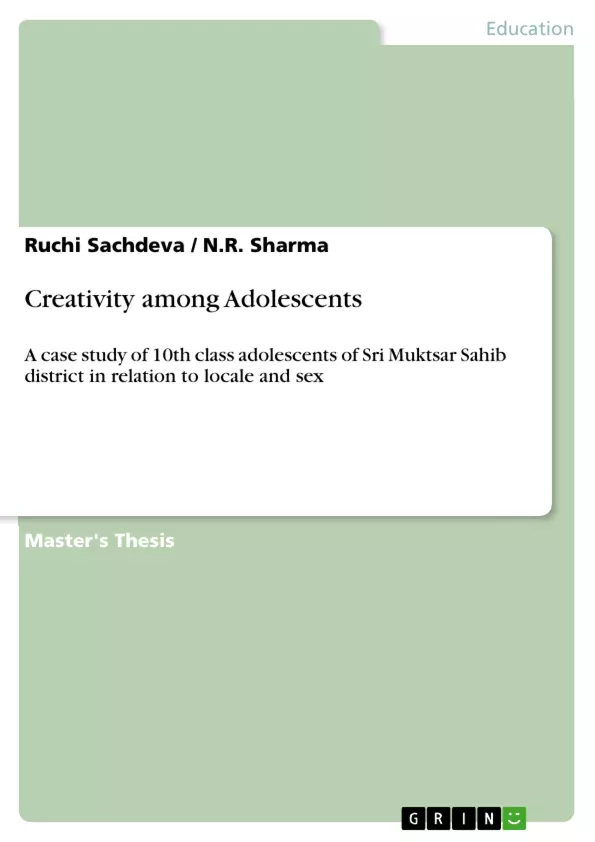Creativity is an asset to human beings which distinguish it from the rest of the flora and fauna organizers. Creativity is, underdoubtedly, the most unique among all the abilities, in the past creativity was attributed as ‘Spark of Genius; or ’revetaties’. But, presently it is attributed to psychic functioning of human being.
Creativity is the capacity or ability of an individual to create, discover or produce a new or novel idea or object, including the rearrangement or reshaping of what is already known to him which proves to be a unique personal experience.
Creativity is one of the highest gifts that nature has bestowed on mass. The present stage of culture, scientific and industrial development that man has attained in largely to be attributed to this gift of creativity. The human world has progresses only with creative abilities in now. These abilities should be identified and developed systematically, and used for the progress of mankind. The development of a society critically depends upon the creativity of the people. Therefore creativity has becomes a chief psycho-social motive of the twentieth century. Creativity enhances the capacity to make changes in the surroundings. In fact it is creativity which has helped society in its evaluation from the animal life to the present development. The total change in a society depends on the cumulative creating capacity of its people to effect such a change. As education is a major agent to bring change in society, there is an urgent need to focus on the role of creativity in educational system, so that people can develop creative skills.
It is commonly held by educationalist and psychologists that creativity factor is important in academic achievement and cognitive power. The creativities of adolescents depend upon many factor like parental encouragement, school environment, teacher encouragement and parents contribution for the creativity of adolescents. Most of creativity of rural, urban students in terms of creativity. This Book deals to study the creativity among adolescents of rural, urban and male, female students to explore the ideas that creativity has relationship in terms of sex and locale
Inhaltsverzeichnis (Table of Contents)
- I. INTRODUCTION
- 1.1 Meaning of Creativity
- 1.2 Adolescence
- 1.3 Need of the Study
- 1.4 Statement of the Problem
- 1.5 Operational Definition of the Study
- 1.6 Objectives of the Study
- 1.7 Hypotheses of the Study
- 1.8 Delimitation of the Study
- 1.9 Organization of the Chapter
- II. REVIEW OF RELATED LITERATURE
- 2.1 Studies in Abroad
- 2.2 Studies in India
- III. METHOD AND PROCEDURE
- 3.1 Design of the Study
- 3.2 Sample of The Study
- 3.3 Tools used
- 3.4 Collection of Data
- 3.5 Statistical Techniques
- IV. ANALYSIS AND INTERPRETATION OF DATA
- V. SUMMARY
- 5.1 Introduction
- 5.2 Creativity
- 5.3 Adolescence
- 5.4 Significance of the Study
- 5.5 Statement of the Study
- 5.6 Objectives of the Study
- 5.7 Hypotheses of the Study
- 5.8 Design of the Study
- 5.9 Tools used
- 5.10 Statistical Techniques used
- 5.11 Delimitation of the Study
- 5.12 Conclusion
- 5.13 Educational Implication
- 5.14 Suggestions for further Study
Zielsetzung und Themenschwerpunkte (Objectives and Key Themes)
This dissertation aims to investigate the creativity of 10th-grade adolescents in Sri Muktsar Sahib District, Punjab, India, examining the influence of locale (urban vs. rural) and sex on their creative abilities. The study utilizes a quantitative research approach to analyze data collected through standardized tests and statistical analysis.- The relationship between locale (urban vs. rural) and creativity among 10th-grade adolescents.
- The relationship between sex (male vs. female) and creativity among 10th-grade adolescents.
- The interplay of locale and sex on the creative abilities of 10th-grade adolescents.
- The application of creativity research findings to educational practices and policy development.
- The identification of potential factors influencing creativity in the studied population.
Zusammenfassung der Kapitel (Chapter Summaries)
- Chapter I: Introduction - This chapter lays the foundation for the study by defining creativity and adolescence, outlining the need for this research, and stating the problem, objectives, hypotheses, and delimitations of the study.
- Chapter II: Review of Related Literature - This chapter explores relevant existing research on creativity, focusing on both international and Indian studies. It examines previous findings and theoretical frameworks related to the study's research questions.
- Chapter III: Method and Procedure - This chapter details the methodology employed in the study, including the research design, sample selection, data collection methods, tools used, and statistical techniques applied.
- Chapter IV: Analysis and Interpretation of Data - This chapter presents the results of the data analysis, including statistical tests and interpretations of findings. It examines the relationship between creativity, locale, and sex, and explores any significant patterns or relationships observed.
- Chapter V: Summary - This chapter summarizes the key findings of the study, highlighting the major conclusions drawn from the data analysis. It discusses the significance of the findings, their implications for education, and suggests areas for future research.
Schlüsselwörter (Keywords)
The primary focus of this dissertation is on the creativity of 10th-grade adolescents, examining the influence of locale (urban vs. rural) and sex on their creative abilities. Key terms and concepts explored in the study include creativity, adolescence, urban-rural differences, gender differences, quantitative research methods, statistical analysis, and educational implications.- Quote paper
- Ruchi Sachdeva (Author), Dr. N.R. Sharma (Author), 2013, Creativity among Adolescents, Munich, GRIN Verlag, https://www.grin.com/document/279774



